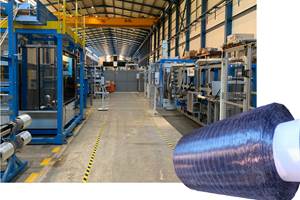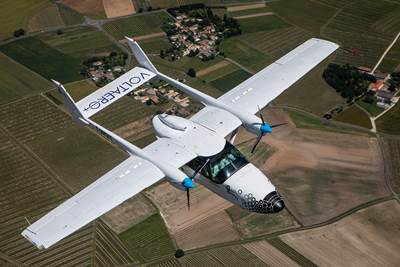VoltAero to build facility for hybrid-electric aircraft in France
Construction bids are now being sought after for the 7,400-square-meter factory, to hold three Cassio aircraft final assembly lines, along with a workshop, logistics area and offices.

Industrial facility rendering. Photo Credit: VoltAero
Bids are being sought for the construction of an industrial site at Rochefort – Charente-Maritime Airport in France’s Nouvelle-Aquitaine region where VoltAero (Médis, France) is to perform the assembly and deliveries of its Cassio electric-hybrid aircraft family. VoltAero says its aircraft may use composites for some components like wings, canards, empennage and booms.
This construction project — issued by the regional association of airports, the Syndicat Mixte des Aéroports de La Rochelle – Ile de Ré et Rochefort – Charente-Maritime — will lead to the creation of a facility with three Cassio aircraft final assembly lines, along with a workshop, logistics area and offices.
Covering a total area of 7,400 square meters — with the possibility for future extensions — the building will initially provide 2,412 square meters of floor space. Project management is the responsibility of the Syndicat Mixte association, and the prime contractor role has been entrusted to the SDArchitectes agency (Rochefort, France).
The project’s cost of €4.4 million (excluding tax) includes road access to the site, as well as a tarmac area for the assembled Cassio aircraft, and a taxiway that connects to the Rochefort – Charente-Maritime Airport’s runway. The French government will contribute €665,000 as part of the National Fund for Territorial Planning and Development (FNADT). Discussions are underway with the Nouvelle-Aquitaine Region and the Agglomeration Community of Rochefort-Océan for their financial support of the project.
Advantages for the development of this aeronautical “industrial hub” will include:
- Quality of existing infrastructure, with a 2,280-meter-long × 45-meter-wide runway that accommodates medium-haul aircraft, along with three taxiways, a control tower, etc.;
- An overall available land surface of 16 hectares, with direct access to the runway;
- An absence of commercial air traffic, for the creation of activities that require frequent access to the runway and airport infrastructure;
- Road access, regional attractiveness and a central location on France’s Atlantic coast;
- A well-established aeronautical industry presence in the greater Rochefort region.
“VoltAero’s presence constitutes a go-ahead for the development of aeronautical industrial activities at the airport,” says Gérard Pons, president of the Syndicat Mixte des Aéroports de La Rochelle – Ile de Ré et Rochefort – Charente-Maritime. “I hope that this first facility will lead to test and development projects from other innovative aeronautical players.”
VoltAero is continuing the development of its Cassio hybrid-electric aircraft family, including the validation of the company’s proprietary electric-hybrid powertrain with flight tests of its Cassio 1 demonstrator — which has logged 135 flight hours while flying more than 10,000 kilometers.
VoltAero will offer three versions of the aircraft:
- Cassio 330, a five-seat configuration with propulsion from a combined hybrid-electric power of 330 kilowatts;
- Cassio 480, configured with six seats and a hybrid-electric propulsion power of 480 kilowatts;
- Cassio 600, with a 12-seat capacity and hybrid-electric propulsion power of 600 kilowatts.
Certification of Cassio is expected at the end of 2024, with the first aircraft expected to be delivered from VoltAero’s Rochefort – Charente-Maritime Airport facility in early 2025.
VoltAero currently employs 35 people. When the new facility is completed, the company will move its operations to Rochefort – Charente-Maritime Airport — which is targeted for June 2024 — with some 60 employees. When the planned production output is reached, the plant will employ 150 people and contribute to the creation of 450 indirect jobs.
Related Content
Novel dry tape for liquid molded composites
MTorres seeks to enable next-gen aircraft and open new markets for composites with low-cost, high-permeability tapes and versatile, high-speed production lines.
Read MorePlant tour: Spirit AeroSystems, Belfast, Northern Ireland, U.K.
Purpose-built facility employs resin transfer infusion (RTI) and assembly technology to manufacture today’s composite A220 wings, and prepares for future new programs and production ramp-ups.
Read MorePEEK vs. PEKK vs. PAEK and continuous compression molding
Suppliers of thermoplastics and carbon fiber chime in regarding PEEK vs. PEKK, and now PAEK, as well as in-situ consolidation — the supply chain for thermoplastic tape composites continues to evolve.
Read MoreManufacturing the MFFD thermoplastic composite fuselage
Demonstrator’s upper, lower shells and assembly prove materials and new processes for lighter, cheaper and more sustainable high-rate future aircraft.
Read MoreRead Next
VoltAero to cross English Channel with Cassio 1 demonstrator aircraft
The repeated electric aviation crossing emphasizes the Cassio program’s development phase advancements, as well as its anticipated 2023 certification.
Read MoreVIDEO: High-rate composites production for aerospace
Westlake Epoxy’s process on display at CAMX 2024 reduces cycle time from hours to just 15 minutes.
Read More“Structured air” TPS safeguards composite structures
Powered by an 85% air/15% pure polyimide aerogel, Blueshift’s novel material system protects structures during transient thermal events from -200°C to beyond 2400°C for rockets, battery boxes and more.
Read More


























